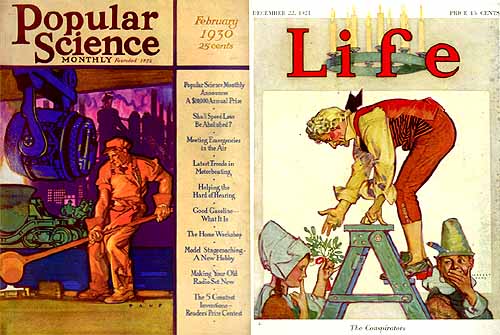
|
Copyrighted Material -CLICK for information |
|
Back |
American Art Archives began in 1998. Then, it was a little web page with a wee bit of artwork and over 100 short illustrator bios. This page got started to help me sell on eBay and help educate buyers as to what I was selling. And why did I need to sell on eBay? Some backstory...
I've liked illustration since I was growing up in the 60s and knew some of the artists from paperback covers, movie posters, and the rare illustrated magazine cover (usually for TV Guide). And of course, there were the artists I knew from the comics, Warren publications, MAD and Cracked, just the sort of trivia flotsam a teen has in his brain. But pre-60s? Of the Golden Age, all I knew was what most folks still know today: Norman Rockwell and Maxfield Parrish. Period.
As a Baby Boomer, I was weened on Vietnam, Watergate, The Brady Bunch and other tragedies. Without me ever knowing it, magazines lost their place as arguably the most popular medium, replaced by three network channels, Pong, and 8-track tapes. It was not yet Morning in America.
Years passed. College: two years as music major, then moved to state college and a BA in English. Various jobs, mostly as a tech/ad copy writer/DTPer/Mac artist. Finally met a special woman who could/would put up with me. We married, started a business together, bought a house, adopted a cat or two, planted tomatoes. Life was good.
Early in our marriage, we managed a trip to New England. New England has antiques. Actual Old Things. Things aren't very old in Los Angeles. Old is considered un-hip, un-cool, and most un-ly of all, un-NEW! An Angeleno's idea of an antique is tofu getting green in the back of the fridge.

The original 2 Paus mags purchased in New England -- in their original state of wear.
But New England, that's history. And there, in a glorious barn of ancient artifacts positively musty with un-newness, was a stack of Popular Science magazines from the eons past. The covers were amazing. No boring photos these. These were three-strip technicolor paintings of men, marvels, and machines, neon brush stroked onto the covers in radioactive watercolors. The artist? Herbert Paus. Herbert who?
Not being much of a collector, I bought only one issue and on the same trip came across a Life cover by Paus and bought that (and just when did Life have painted covers anyway -- so much to learn). Vacation over. Back in LaLa Land. More years pass. Years without coming across another Paus, or anyone like him.
In the late 90s, New England was no longer on the other coast. It was cyberized to a destination -- along with thousands of attics, garages, and basements -- right to my Mac's desktop. eBay had arrived. If the Colt revolver was the great equalizer of the West, then eBay is the great equalizer of the Collector. A collector no longer has to scour the lower 48 for that rare item; the lower 48 comes to the Collector. In short order, I had every Popular Science Paus did a cover for, as well as all of the Life mags I could find. And then I found out he did Collier's weeklies. And American Magazine. And other mags. And ads. Lots of ads. And books. And World War I posters. HE DID A TON OF STUFF.
And so did other artists I unearthed along the way. One can't very well collect Paus without coming across the brothers Leyendecker, E M Jackson, Christy (Howard Chandler AND Earl), Harrison Fisher, Coles Phillips, and it never seems to end and then there are the artists I come across that there's simply NO information on.
But as I said, I'm not much of a collector. So, for the most part, I scan something, clean it up digitally, and no longer needing the original, I can sell/auction it off -- that's where eBay comes in and that's how the American Art Archives page started.